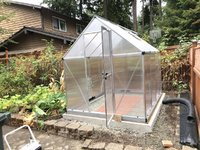Nebari Progress….
About two years ago we were testing a way to accelerate the growth of azalea nebari. We used the contest test as an example, along with quite a few others not shown. Today will see how this experiment went.
This experiment was inspired by a comment Roberta Walters, a Gondo instructor, at a Puget Sound Bonsai Association meeting
(see YouTube 4.2001) In it she responded to a question about how to create a good nebari. Roberta’s response was to bury the nebari deep to create fat roots.
Coincidently Michael Hagedorn discusses this very topic using Maples on his blog this week.)
This is contrary to what a lot of azalea people do with a new tree, instead bringing whatever nebari is there up to the surface and attempt to grow the nebari out from there.
So we decided to try our Roberta’s advice… on steroids.
About three years ago we began installing ‘base collars’ (our name) atop the nebari section of a number of azaleas. My better half didn’t like the aesthetic, but what the hey, that’s science!
Hers’s what this tree looked like the first year the collar was installed. Both the collar was installed, biochar was added to the media. and a thick layer of mountain moss was maintained. Specific shallow rooted succulents were encouraged to grow in the moss to help boost activity in the rhizosphere. ( the collar was a cut down yogurt container - also used cut down cottage cheese container tops for larger trees).
View attachment 536826
The collar was removed in 2023 after two years.
Image today almost a year later.
View attachment 536827
Moss removed
View attachment 536828
Tree out of the pot
View attachment 536829
After surface cleaning. A well formed conical nebari with fine roots over the top is present. Looks great! It seems the base collars did the job well, fostering close to the trunk growth of the nebari. Is this the only way to achieve these results? Not sure. But I do now the untreated nebari on our trees tend to be much flatter. So an idea for other azalea folk to try out.
View attachment 536830
Following up. Repotting in the same container… (was raining throughout).
Note small guage tie wires crossed, media added, tree tied down and thickly mossed with mountain moss tucked into the nebari and top of the media.
View attachment 536839 View attachment 536831 View attachment 536832
Bird screen installed and tree sprayed, then soaked 20 minutes, then sprayed again.
View attachment 536833
Back on a bench in afternoon shade with some other buddies to play.
View attachment 536845
cheers
DSD sends



































